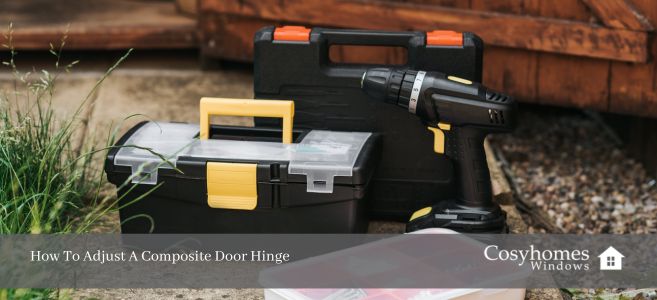Having a composite door that isn’t shutting properly may mean that you need to adjust the hinges. Don’t worry, it’s not difficult to do with the right tools and can be a rewarding task. In this article, look at the signs that composite door hinge adjustment is needed and a guide to help you adjust your door hinges.
Signs That Adjustment is Needed
There are some tell tale signs that show that you need to adjust a composite door to its correct position, including misaligned hinges, difficulty opening and closing the door fully, and poor energy efficiency. Good quality doors should stop draughts and keep your home secure.
Before you beginning adjusting the door hinges, you need to check whether your door is level. You can do this by placing a spirit level on top of the composite door. If it is not level, you will need to adjust the door hinges.
Step-by-Step Adjustment Guide
Adjusting the door hinges on a composite door can be a tricky but rewarding task. With the help of our guide and the right tools needed to make the adjustments, you should be able to do this yourself.
Gather the Necessary Tools
Begin by making sure that you have the tools you need to adjust the door hinges, including:
- A screwdriver
- A hammer
- A level
- A tape measure
- An allen key – depending on the type of hinge on your door
- A hex key – again, this will depend on the type of hinge on your door
Assessing the Situation
- Check the gap between your door and the door frame all the way around. If there is an uneven gap, this means that it is out of alignment.
- If the composite door isn’t functioning properly, for example the bottom of the door scrapes the floor when you open it or the door won’t lock easily, this is also a sign that there is an hinge misalignment. Making your door secure, particularly if you have a composite front door, is very important.
- Check what type of hinge plates you have on your door. There are many different hinges including:
- Piano Hinges – a long thin hinge that runs the entire length of the door. More common on a heavy door.
- Ball Bearing Hinges – a hinge with a ball bearing in the middle that allows the door to swing smoothly.
- Butt Hinges – a plain butt hinge has a pin that joins the two plates at the hinge’s knuckles. These are probably the most common type of hinges due to their reliability.
Loosening the Hinge Screws
For this part of the guide, we are going to look at how to adjust butt hinges on a composite door.
- Turn the bottom/top screw, using your screwdriver, to get sideways movement. Pay careful attention that you don’t remove the screws entirely, as you will need to put them back in the same place later. You can now begin to adjust your composite door.
- Adjust the butt hinge using an allen key, removing the cap on top to expose the screw.
- If there is a grub screw in the centre of the hinge, you must loosen before you adjust the pin as it holds the pin in place.
Realigning the Door
If the misaligned door slightly catches on the top of the door frame you will need to adjust the door height. The door will need to be lowered by adjusting the bottom hinge.
- Remove the centre covers of your hinge by hand and then, using an allen key, loosen the socket screws by about a ⅓ of a turn.
- Next, you will need to lift and support the door to the required height whilst securing the socket screws. It’s important that you don’t forget to replace the covers.
A composite door catching on the floor means that you will need to adjust the top hinge.
- Use an allen key at the door side of the hinge. Turn the screw 1-2 rotations clockwise. Then, test your door to see if it still drags. Continue to adjust hinges and tighten the screws until you get a smooth door that doesn’t drag.
Final checks
- Once you have adjusted the hinges, you will need to check that the door is level again. You can check by opening the composite door slightly on the lock side, looking up and down the frame to see if the gap is consistent throughout or whether it needs more adjustment.
Conclusion
We hope you found this article useful if you need to adjust composite doors in your home. With the right tools and some guidance, this is something you can do yourself. However, if you feel that the issue with your door is not a quick fix, do contact your original supplier or contact us for assistance.
If you have another type of door that you think needs adjustment, our handy articles on patio door adjustment and bifold door adjustment can help.


















No Response to "How To Adjust A Composite Door Hinge"